
Mtskheta is a city in Mtskheta-Mtianeti province of Georgia. One of the oldest cities of Georgia and its former capital, it is located approximately 20 kilometres north of Tbilisi, at the confluence of the Mtkvari and Aragvi rivers. Currently a small provincial capital, for nearly a millennium until the 5th century AD, Mtskheta was a large fortified city, a significant economical and political centre of the Kingdom of Iberia.

Jvari Monastery is a sixth-century Georgian Orthodox monastery near Mtskheta, eastern Georgia.Jvari is a rare case of the Early Medieval Georgian church that survived to the present day almost unchanged. The church became the founder of its type, the Jvari type of church architecture, prevalent in Georgia and Armenia. Built atop of Jvari Mount, the monastery is an example of harmonious connection with the natural environment, characteristic to medieval Georgian architecture. Along with other historic structures of Mtskheta, the monastery was listed as a World Heritage Site by UNESCO in 1994.

Gergeti Trinity Church is a popular name for Holy Trinity Church near the village of Gergeti in Georgia. The church is situated on the right bank of the river Chkheri, at an elevation of 2170 meters, under Mount Kazbek.

Urbnisi is a village in Georgia’s Shida Kartli region, in the district of Kareli.
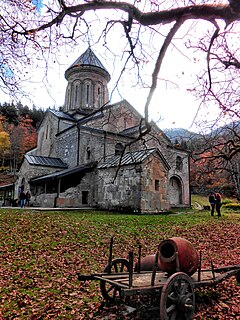
Kintsvisi Monastery is a Georgian Orthodox monastery in the Shida Kartli region, eastern Georgia, 10 kilometers from the town Kareli, on a forested slope of a high mountain of the Dzama valley. Its main church is an exceptional example of a brick church from the Georgian Golden Age period. The monumental mural is one of the largest among the Medieval Georgian artistic ensembles.

The Sioni Cathedral of the Dormition is a Georgian Orthodox cathedral in Tbilisi, the capital of Georgia. Following a medieval Georgian tradition of naming churches after particular places in the Holy Land, the Sioni Cathedral bears the name of Mount Zion at Jerusalem. It is commonly known as the "Tbilisi Sioni" to distinguish it from several other churches across Georgia bearing the name Sioni.
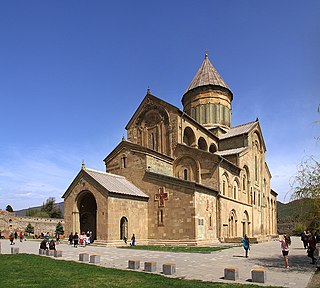
The Svetitskhoveli Cathedral is an Orthodox Christian cathedral located in the historic town of Mtskheta, Georgia, to the northwest of the Georgian capital Tbilisi. A masterpiece of the Early and High Middle Ages, Svetitskhoveli is recognized by UNESCO as a World Heritage Site. It is currently the second largest church building in Georgia, after the Holy Trinity Cathedral.
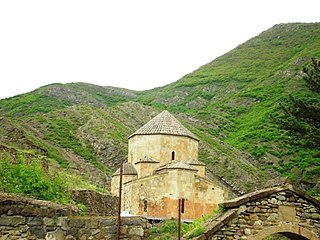
The Ateni Sioni Church is an early 7th-century Georgian Orthodox church in the village of Ateni, some 10 km (6.2 mi) south of the city of Gori, Georgia. It stands in a setting of Ateni gorge in the Tana River valley known not only for its historical monuments, but also for its picturesque landscapes and wine. The name "Sioni" derives from Mount Zion at Jerusalem. Ateni is the tetraconch church, typical for the period. Its frescoes are one of the best examples of the Georgian painting.

The architecture of Georgia refers to the styles of architecture found in Georgia. The country is exceptionally rich in architectural monuments. Characteristic features of the Georgian architecture are monumentality, clear composition, strict proportions, moderate use of decorations, and above all these the harmonic interaction with nature.

Samtavisi is an eleventh-century Georgian Orthodox cathedral in eastern Georgia, in the region of Shida Kartli, some 45 km from the nation's capital Tbilisi, near Igoeti village. The cathedral is now one of the centers of the Eparchy of Samtavisi and Gori of the Georgian Orthodox Church. The church is a typical example and the founder of the Georgian interpretation of the cross-in-square churches. It was built in the period of decorative and artistic bloom in the architecture of Georgia.

The Ikorta church of the Archangel, commonly known as Ikorta (იკორთა) is a 12th-century Georgian Orthodox church located at the outskirts of the village Ikort’a in Shida Kartli region of eastern Georgia. The church was originally a part of Ikorta castle, from which only the citadel and the church remain.
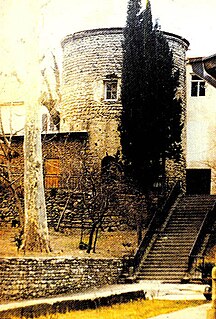
Tower of Mirian is a tower built by the King of Georgia Mirian III in the 4th century. It is located on territory of Samtavro Monastery.

Sapara Monastery is a Georgian Orthodox monastery in the Akhaltsikhe District of Samtskhe-Javakheti region, Georgia.

Kumurdo Cathedral is a Georgian Orthodox Cathedral. It is situated on Javakheti Plateau, 12 km (7.5 mi) southwest from Akhalkalaki. According to the inscriptions on the walls, written with the ancient Georgian writing of Asomtavruli, the Kumurdo Cathedral was built by Ioane the Bishop during the reign of king of the Abkhazians Leon III in 964. It is the first church with emerging features of the 11-13th century architecture of Georgia. During the Middle Ages, Kumurdo was an important cultural, educational and religious center. The cathedral was restored twice, but it stands without a dome. In 2015, a project for full reconstruction of the cathedral was developed.
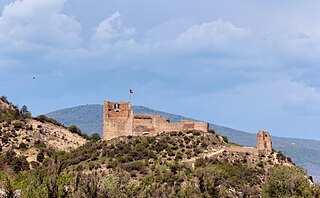
Bebris Tsikhe is an early medieval fortress in Georgia in the historical region of Kartli, Mtskheta. It situated on the right bank of the river Aragvi, on the north of Mtskheta. In ancient time the fortress was called ″Belti″. Vakhushti Bagrationi calls it ″Beltistsikhe″. The fortress was built to protect Mtskheta and Tbilisi from the north, from the side of the Greater Caucasus Range.
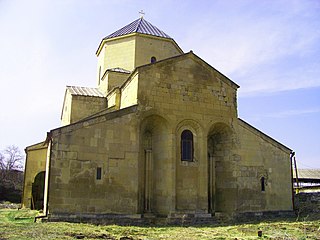
The church of Tsromi is an early medieval church in village Tsromi, in the vicinity of town Khashuri, in Shida Kartli region of Georgia. It is situated at the center of the village, along the right side of the river Mtkvari (Kura).

The Tsilkani cathedral of the Mother of God is a Georgian Orthodox church in the village of Tsilkani, Mtskheta Municipality, in Georgia's eastern region of Mtskheta-Mtianeti. Originally built in the 4th century, the church was repeatedly remodeled in the Middle Ages. The extant edifice is a domed cross-in-square design, contained in a walled enclosure with corner towers. It is inscribed on the list of the Immovable Cultural Monuments of National Significance.

Aghaiani church of Saint Nino is an early medieval Georgian Orthodox church on Mount Tkhoti, 2 km southeast of the village of Aghaiani in the Kaspi Municipality in Georgia's Shida Kartli region. It stands at the place of one of the three wooden crosses erected—according to historical tradition—at the behest of Saint Nino to mark adoption of Christianity by the people of Kartli. The extant structure is a hall church, a 9th–10th-century remodeling of an earlier cross-in-square building. The church is inscribed on the list of Georgia's Immovable Cultural Monuments of National Significance.

The Ruisi cathedral of the Mother of God is a Georgian Orthodox church in the village of Ruisi in Georgia's east-central Shida Kartli region. Originally built in the 8th–9th century, the church was remodeled in the 11th century and rebuilt in the 15th century. It is a cross-in-square church with a tall dome and a horseshoe apse on the east. The cathedral is inscribed on the list of Georgia's Immovable Cultural Monuments of National Significance.

Mount Bagineti, is a mountain on the eastern slope of Trialeti Range, a part of Lesser Caucasus Mountains, in the Republic of Georgia, situated at the confluence of rivers Kura and Aragvi, near the ancient city of Mtskheta.

























